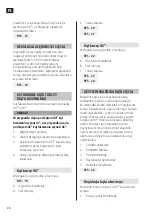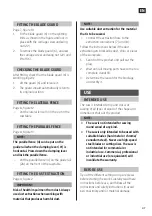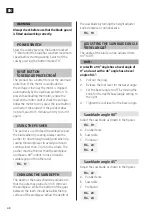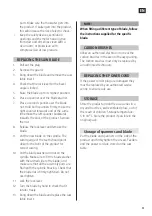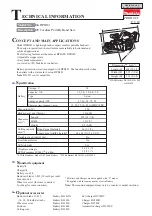
EN
49
3. Check that the workpiece does not go
against the blade before starting the
product.
4. When sawing long workpieces put a
support with the same height as the
saw table behind the saw to support the
workpiece.
5. Start the saw.
6. Place the workpiece flat on the saw table
with one edge firmly pressed against the
parallel fence. Allow the blade to reach
maximum speed before it makes contact
with the workpiece.
7. When the blade comes in contact with the
workpiece, guide it with the hand nearest
to the parallel fence. Make sure that the
workpiece is firmly flush with both the
parallel fence and the surface of the saw
table.
FIG. 28
FIG. 29
8. When sawing thin workpieces, use the
pusher to move the workpiece past the
blade.
9. Switch off the saw after sawing. Do not
remove the workpiece before all moving
parts have completely stopped.
MITRE SAWING
1. Remove the parallel fence.
2. Adjust the blade to the correct depth for
the thickness of the workpiece.
3. Set the mitre pointer to the required angle
and tighten the lock knob.
FIG. 30
4. Check that the workpiece does not go
against the blade before starting the saw.
5. Start the saw.
6. Allow the blade to reach maximum
speed before it makes contact with the
workpiece.
USING THE MITRE POINTER
The mitre pointer ensures a high degree
of precision when mitre sawing. It is
recommended to saw sample test pieces for
very fine tolerances. There are two slots for the
mitre pointer, one on each side of the blade.
Either of the slots can be used for cross-cutting
with a bevel angle of 90°. When bevel sawing
(the blade at an angle to the saw table) the
mitre pointer should be placed in the slot on
the right side, so that the blade angles away
from the pointer and your hands.
1. Indicator arrow
2. Angle scale
3. Lock knob
4. Adjustable fence
5. Wing nut
FIG. 25
Adjusting the mitre angle
The mitre pointer can be turned 60° to the
right or left.
1. Release the lock knob.
2. Put the mitre pointer in the slot and turn
it to the required angle on the scale.
3. Firmly tighten the knob.
RIP SAWING
1. Parallel fence
2. Clamp
3. Wing nut
FIG. 26
1. Adjust the blade to the correct depth for
the thickness of the workpiece.
2. Place the parallel fence at a suitable
distance from the blade for the actual cut
and firmly lock the lever. In position 0 the
parallel fence is in line with the saw blade.
FIG. 27
Содержание 017711
Страница 4: ...1 ...
Страница 5: ...2 3 ...
Страница 6: ...5 4 6 7 ...
Страница 7: ...10 11 9 8 12 ...
Страница 8: ...13 ...
Страница 9: ...15 ...
Страница 10: ...16 ...




